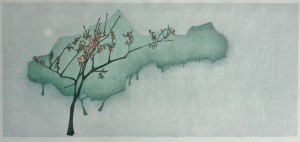Recently I stepped away from having a paper diary and into the cloud world of an electronic diary. The idea of relying on a cloud to keep me up to date with the daily dance of students, galleries, teaching venues, delivery dates (not to forget cat inoculations, the dentist and birthdays) is not terribly confidence inspiring. However, it seems to work and my also-new android phone trills and buzzes with reminders and updates, telling me that I am so terribly important now.
I know artists traditionally have the reputation of being above such mundane tasks, but the fact is that, however fabulous the work, nobody loves an artist who is late or forgets to sign contracts, delivers work on the wrong day or, my personal nightmare, doesn’t turn up to teach their class. There are precious few of us famous enough to get away with this sort of flaky behaviour. It’s my experience that an artist’s reputation is as fragile as a Hardy heroine’s: once the word gets out that you are trouble, people will move on. The plus side to this is that a reputation for being on time, on budget, well prepared and generally efficient will result in work, bookings and happy galleries.
This was brought home to me today when I finally compared my Cumulonimbus’s worth of teaching and exhibiting dates with the events and teaching pages on my web site – disaster! I’ve slipped out of sync and had to spend several hours updating. That opens up the can of worms that is web site maintenance (another time I think, I’m stressed enough as it is). I guess I will have to add yet another task to the diary to update regularly so this doesn’t happen.
I don’t suppose it matters how you keep a diary; I’ve had all sorts in my time from lockable ones (two days worth of serious teenage angst and then forgotten), an eighties filofax (too big) through Moleskines (so hip) to the cloudy one. The point is to pay attention to it. I am very late to the electronic diary, but now I have it I find it has two great advantages: it chirrups until I pay attention plus I can book courses in a year or two ahead without scrawling hopefully in the back of the current year. The only thing I miss is the annual choosing of the colour…


